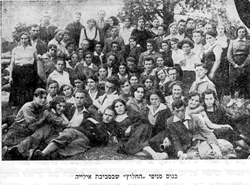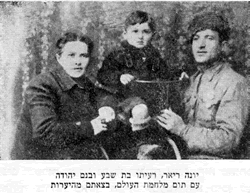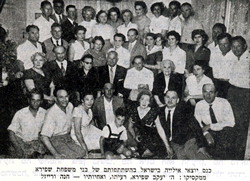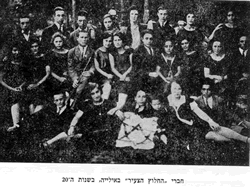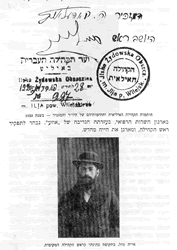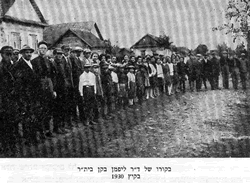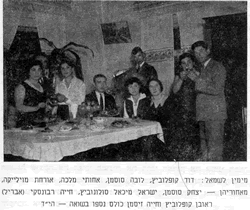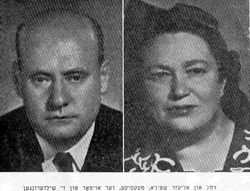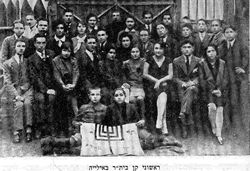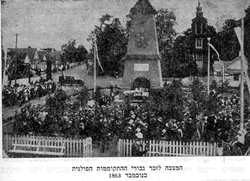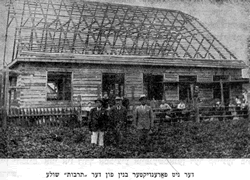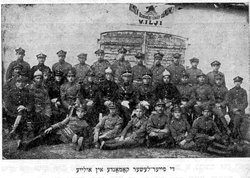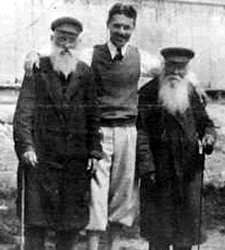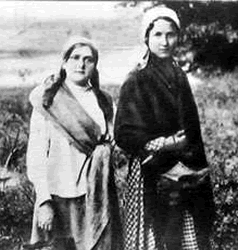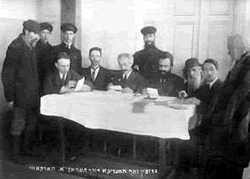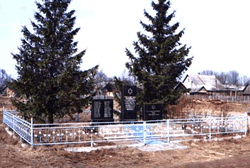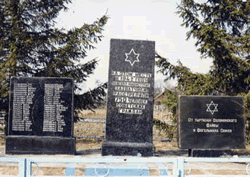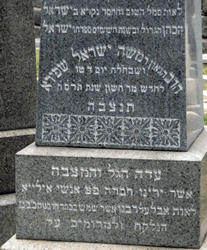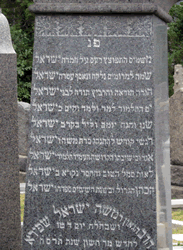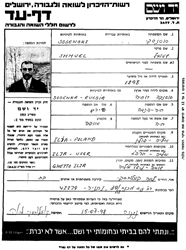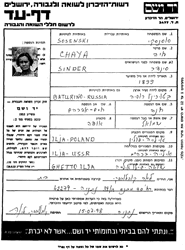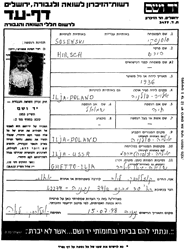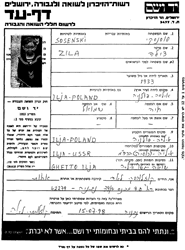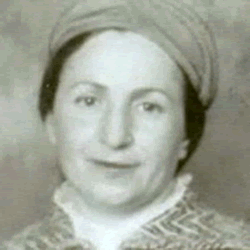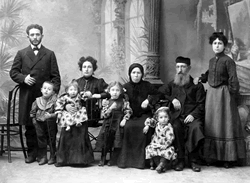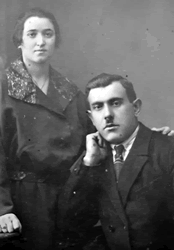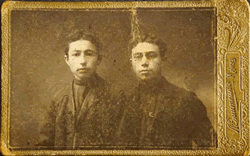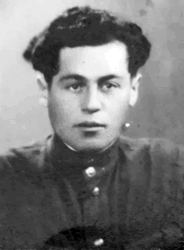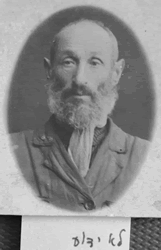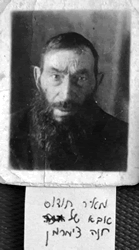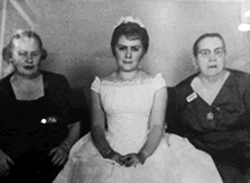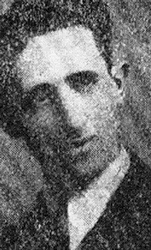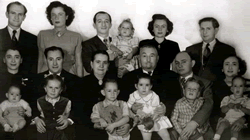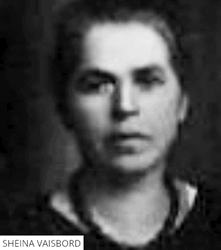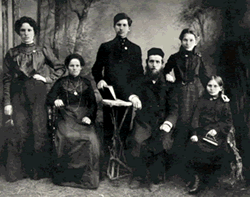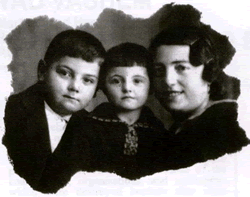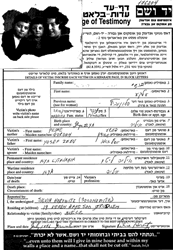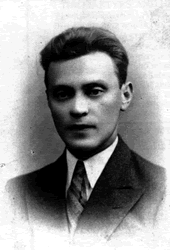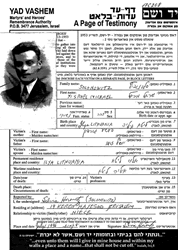Latitude: 54º25' Longitude: 27º18'
Also known as Ilia, Iliya, and Ilja
37.3 miles NNW of Minsk
http://www.jewishgen.org/belarus/shtetls/shtetl_detail.php?filename=silyavv
|
#ilja-1: A meeting of members of Hachalutz Zionist movement in the Ilja area. |
#ilja-2:
|
#ilja-3:
|
|
#ilja-4: 1920s' members of the Zionist "Hachalutz Hazair" |
#ilja-5:
|
#ilja-6: Ilja, summer of 1930- Dr. Lipman visits the Zionist "Bitar Youth Movement" |
|
#ilja-7: From the right: David Kopelovitz, Luba Susman, Malka Kopelovitz, a guest from Vileika, standing in the back Yizhak Susman, Yisrael Michael Solonovitz, Chaia Rabunski ( Ab/vril?) , Reuven Kopelovitz and Chaya Zisman- They all perished in the holocaust. |
#ilja-8:
|
#ilja-9: The founders and first members of Bitar in Ilje c 1930 |
|
#ilja-10: Ilja 1920s; By the memorial for the heroes of the Second Polish revolt against Russian rule ( the revolt took place in November 1863) |
#ilja-11: The unfinished "Tarbut Jewish School " in Ilja |
#ilja-12: members of the Ilja fire department |
|
#ilja-13:
Dr. Hyman Sparber, from America, photographed with his grandfather,
Avrom Sparber, and his boyhood teacher, Reb Elye [r] who is 100
years old.1920s.
|
#ilja-14:
These two Jewish girls from Iwie, disguised themselves as 'shikses'
[Gentile girls] during the war to be able more easily to peddle
saccharine around the army camps. April 27, 1924.
|
#ilja-15:
Outdoor portrait of seven young men: A secret meeting of a group
of revolutionaries held in the woods. 1903.
|
#ilja-16: Alexander Harkavy (seated, center), a representative of the American organization HIAS during a visit to Europe, posing at a table with representatives of various community groups.1920. |
#ilja-17: memorial to the perished |
#ilja-18: memorial to the perished |
| #ilja-19: The grave of Rabbi Moshe Yisroel Shapira of Ilya |
#ilja-20: Grave of Rabbi Moshe Yisroel Shapira, Washington Cemetery,in Brooklyn |
#ilja-21: Washington Cemetery, Brooklyn |
| #ilja-22: Sosenski Shmuel |
#ilja-23: Chaja Sosenski was born in Baturino in 1901 to Khaim Avraham Sinder and Khana. She was a housewife and married to Shmuel. Prior to WWII she lived in Ilja, Poland. During the war she was in Ilja, Poland. Chaja perished in 1942 in Ilja, Poland. This information is based on a Page of Testimony (displayed on left) submitted on 09-Apr-1956 by Leah Kosolovski, her daughter, a Shoah survivor. |
#ilja-24: Sosenski Hirsch |
| #ilja-25: Tzila Sosenski was born in Ilja in 1933 to Shmuel and Khaia. Prior to WWII she lived in Ilja, Poland. During the war she was in Ilja, Poland. Tzila perished in Ilja, Poland. This information is based on a Page of Testimony submitted on 15-Jul-1998 by her sister Leah Kosolovski. |
#ilja-26: Gertrude Kudrow (nee Farberman) grandmother of Lisa Kudrow |
#ilja-27: |
#ilja-28: Ilya c 1916 Elijah Reiss |
#ilja-29: If you recognize the person / people in the picture write to Shimon Bakalchuk |
#ilja-30: If you recognize the person / people in the picture write to Shimon Bakalchuk |
#ilja-31: If you recognize the person / people in the picture write to Shimon Bakalchuk |
#ilja-32: If you recognize the person / people in the picture write to Shimon Bakalchuk |
#ilja-33: If you recognize the person / people in the picture write to Shimon Bakalchuk |
#ilja-34: On the left Rosa Cwilich (nee Shapiro) |
#ilja-35: Moshe Zawodnik was born in Ilja, Poland in 1912. Prior to WWII he lived in Ilja, Poland. |
#ilja-36: Some of The older members of the Gerson family were from Ilya |
#ilja-37: Sheina Vaisbord was born in Ilja, in 1896 to Rachel and Yosef Sosensky. She was married to Elykim Veisbord and had 2 children Prior to WWII she lived in Radoszkowice, Poland. Sheina was murdered in the Shoah. Report by her cousin Tuvia Sosensky a holocaust survivor. |
#ilja-38: |
#ilja-39: |
Please share your comments or photos or links for posting on our Guestbook Page here: egl.comments@gmail.com
Podberesky family c. 1902
LEFT: Ethel Farberman Gordon – married to Max Podberesky "Gordon" . Center, standing: Philip Podberesky "Gordon" who left for America c.1910 and married Ethel Farberman's sister Katie. The two sisters were from Dolhinov. The brothers and sisters were also cousins. Right, standing: Dishke-Libby nee Podberesky who married Izadore Levine (also a cousin). She was shot in the leg during protests/strikes in NYC for ladies garment workers.
Seated: Ester Genya – 2nd wife of Zev Wolf Podberesky . His first wife, Basha-Ita Danischevsky (also known as "Alte" because she was the sole survivor of 11 children who died as infants) died at approximately age 33, shortly after my grandmother (far right) was born). Center seated: my great grandfather Zev Wolf Podberesky (he was born in Vishneveh). When all of the children except Rivka-Baila (my grandmother) had left for America, he and Rivka Baila and Ester Genya were (living in Ilya) caught in the ravages of WWI and the Russian Revolution and became stateless refugees. Esther Genya had a farm near Smargon and during the Russian Revolution or WW1 went to gather food there and was never heard from again. Zev Wolk and Rivka Baila were forced from their home in winter. During that time he died of pneumonia and she was left alone. She wandered for 4 more years before walking to to the free port of Danzig and coming to America. Far Right: my grandmother, Rivka-Baila (she married Joseph Schuster from Bozalia, Ukraine)
Note: They all dropped the name Podberesky and took the name "Gordon" upon coming to America. For more pictures and information go to; http://www.eilatgordinlevitan.com/volozhin/vol_pages/vollinksframe.html
and click:
Rare Antique Russian Imperial Samovars
Zane Buzby
Birthplace Of Manasseh Ben Joseph. The Jewish Population Numbered 894
In 1847, 829 (58% Of The Total Population) In 1897, And 586 (40.2%) In
1921. On September 17, 1939, The Soviets Entered The Area. On The
Outbreak Of War Between Germany And The U.S.S.R. On June 22, 1941,
Some Jews Managed To Escape Eastward Into The Soviet Union. Ilya Was
Occupied By The Germans In Early July. A Ghetto Was Set Up In Early
October. In January 1942 The Youth Began To Organize And Make Contact
With The Partisans. On Mar. 14, 1942, When Soviet Partisans Attacked
The Chocienczyce Estate Near Ilya Some Jews Who Worked There Joined
Them And Went Into Hiding With Them In The Forests. The Following Day
The S.S. Arrived In Ilya And Accused The Jews Of Cooperating With The
Partisans. On March 17 Jews Were Ordered To Assemble In The City
Square. The Head Of The Judenrat, Josef Rodblat, Was Ordered To Hand
Over Those Connected With The Partisans But He Refused To Cooperate,
And Instead, With David Rubin, Encouraged Escape To The Forests. The
Germans Immediately Began To Liquidate The Ghetto, Shooting The Sick
And Aged On The Spot. Twenty Artisans And Their Families Were
"Selected"; The Rest Of The Jews Were Brought To The Cold Storage
Depot Built By The Soviets Nearby And Murdered. Subsequently, The S.S.
Set Fire To The Depot And Burned The Bodies. Approximately 900 Persons
Perished. The Remaining Members Of The Community Were Murdered On June
7, 1942.
http://freepages.genealogy.rootsweb.ancestry.com/~jlevinson/ilya.html.
-- From The Jews of Bielorussia During World War II, pp. 138, 211-212
Underground members from the Ilja ghetto, some seven kilometers from
the former Soviet-Polish border, looked for contact with the partisans
in the Minsk and Pleszczenice forests. After the Vidz ghetto received
not too encouraging news from the forest and after a wounded partisan,
Leib Wolak, was brought to the ghetto becasue there was no doctor in
the forest to treat him, two underground members--Noah Svirsky of
Hechalutz Hatzair and Zalman Silber–went to the forest to examine the
conditions there. They met a group of partisans and came to an
agreement with them that Jes from the ghetto would be permitted to
join the units of the partisans. On their way back to the ghetto,
Svirsky and Silber acquired a rifle, killed collaborators, and burned
their houses. The first aktzia on Ilja on 17 March 1942, in which
about 900 Jews were murdered, was carried out shortly after a partisan
operation in the region. The second aktzia, on 7 July 1942, in which
some 300 Jews were killed also came after another partisan attack. The
second half of 1942, during which the pace of annihilation was greatly
accelerated, was also a peak period of Jewish flight to the forests...
http://freepages.genealogy.rootsweb.ancestry.com/~jlevinson/ilya.html.
Subscribe to IlyaResearchGroup
Ilja-a |
Ilja-b |
Ilja-c |
Ilja-d |
Ilja-a - Ilja-d
Dear Naomi,
Did you see the Yad Vashem reports by Yisrael michael's niece?
Yisroel Michael Solonowitz was born in Ilja, Poland to Yosef and Pasha nee Gordon. He was married. Prior to WWII he lived in Ilja, Poland. During the war he was in Ilja, Poland. Yisroel was murdered/perished in the Shoah. This information is based on a Page of Testimony (displayed on left) submitted by his niece Silvia nee Solonowitz of Jerusalem.
He must have at certain point moved to Vileyka since there are reports for him and his family ( wife and a child with unknown names ) in the Yizkor book for Vileyka. I do not see a report for him from those who survived from Ilja ( they gave many reports for their town people).
Solonovich, Yisrael Mikhael
Wilejka, Poland
List of murdered Jews from Yizkor books
Solonovich, First name unknown
Wilejka, Poland
List of murdered Jews from Yizkor books
Solonovich, First name unknown
Wilejka, Poland
List of murdered Jews from Yizkor books
He had 2 sisters who also perished;
Elke Barshai nee Solonovich was born in Ilja, Poland to Yosef and Pasha nee Gordon. She was married. Prior to WWII she lived in Ilja, Poland. During the war she was in Ilja, Poland. Elke was murdered/perished in the Shoah. This information is based on a Page of Testimony (displayed on left) submitted by her niece.
On Tue, Apr 2, 2013 at 11:23 PM, Naomi Miller <naomiller@.com> wrote:
Dear Eilat,
I found this picture on your website of Yisro'el Micha'el Solonovich/Soloniewicz/Solonowich (variant spellings) of Ilya/Ilja, Belarus. Do you have any information about him? I believe his mother was Peshe/Pesya Solonovich (nee Gordon) & his maternal grandmother was Yehudit Gordon (nee Hendel or Gendel) married to Moshe Gordon. Yehudit Gordon (nee Hendel or Gendel) was my great-great grandmother's sister Drayze Kosovski (nee Hendel or Gendel). Is there anyone from Ilya/Ilja, Belarus who is living who may remember the man in the picture?
Yisroel Micha'el Solonovich (however it's spelled) is sitting down in the middle of the picture. He lived in Ilja/Ilya, now part of Belarus. I guess he was born there. I guess his mother Peshe/Pesya lived there as well. Maybe his grandmother Yehudit lived there as well.
The Editor (Arie Kopilovitz )
page 9
Donated by Florence Koplow
Translated by Milette Shamir
Introduction
With excitement and awe, stooping under the burden of our sorrow, loss, orphanhood and helplessness, we present to the reader The Book of Ilya. This is our modest contribution to the communal tombstone, erected to immortalize the memory of tens of thousands of the communities of Israel, and millions of brothers, who perished in the hands of the Nazi enemy and his helpers: who were tortured, starved, murdered, burned, and killed in strange ways - during the days of the horrendous Holocaust, the like of which never occurred in the history of our people and of the world. We have no words to describe even the minutest part of the vivid life of our town and the dimensions of the tragedy of its destruction, a tragedy that took place before the very eyes of the indifferent and uncaring people of the world. The Holocaust - that cut down a third of our people - cannot be measured by its astounding results only, without considering the quality of those who perished. We lost our best creative talents, who would have been able, perhaps, to provide a more fitting and appropriate description of the town's life and the dimensions of its tragedy. And although we are not worthy, fate has assigned this mission to us.
After much effort, the collection of material for the Book of Ilya is completed. We can now bless the effort and say that the job was not an easy one, for many reasons; because of the scarce numbers of our town's residents in the world who survived its destruction; since the community's records, where the main events of the town since its establishment were probably written - were destroyed; for lack of reliable sources from which we could glean information on the ancient town and its history; due to the fact that most of the survivors, who live in Israel, are relatively young, and did not have time to absorb within them the town's culture and history, and the few that did, lost it during their many travels and struggle for survival. All of the above prevented us from presenting a correct and full picture of the glorious past of the town and its effervescent life in the period between the two wars. In addition: we should consider the objective fact that the main burden of writing this book was assigned to only few people and that flawed the description. Despite all, we tried to summarize what was available under the present conditions and to include it in the book. It is our duty to gratefully mention all those who gave of their time, energy and abilities, material or literary, to the writing of this project. First and foremost, let us bow our heads before the grave of our town's resident Tuvia Chefetz, rest his soul, who initiated the idea and forced us to materialize it, taking the editorial task in his own hands. But how strange sometimes are the ways of fate. The man who longed to commemorate the town did not manage to do so, and died before the project began. May his memory be blessed and retained forever in our hearts. With gratefulness we mention our town's members, the sons of Tzemach Shapira, rest his soul, from Mexico and the U.S., that thanks to their moral support, their crucial financial contribution, and their constant personal involvement - our tiny birth town, Ilya, gained this eternal tombstone. We are proud of the respectable appreciation letter to our friends the brothers Shapira, written by Mr. Yossef Vintzki from Mexico, and hereby publish it verbatim with much pleasure:
" [in Yiddish] ......."
A heartfelt thanks also to Mr. Chaim Levin from the Kibbutz of Ramat Hakovesh. Despite the fact that the man is past his prime, he did not worry about his health and came to see us in the evenings, to tell of his memories of the town's events. Let us wish that we will all have the privilege of blessing him on his 120th birthday. [
Hearty blessings to all of Ilya's sons in Israel and in the Diaspora: in the United States, Argentina and Mexico. Especially to Zusman Geitlitz, Shlomo Koplovitz and Eliezer Dinerstein and to the members of the committee for the union of Ilya's descendants in Israel. To all the friends who contributed their writing, money, pictures and time to the publication of this memorial book - our deep thanks. All have a considerable part in the project of commemorating the town and its martyrs. To my friend and work mate, Matityahu Bar Ratzon, for his advice on editorial matters and his interest in the progress of this work - my warm blessing.
To my dear and loyal wife Miriam, who encouraged me to continue work despite the many difficulties and unpleasant obstacles I faced - I send the blessing of a loving and admiring husband. This book enfolds a long history of the life of a tiny, ancient and lively Jewish community, and the details of its final destruction are at your disposal. Let it serve as an eternal tombstone, to bring together the generations of the past, the present and the future. The editor.
P H O T O G R A P H - The Shapira Brothers of Mexico, the main contributors to the publication of the memorial book. Standing from right to left: Ya'akov, Yehoshua, Gershon. Seated: Eliezer
